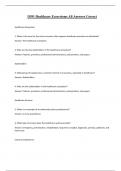D391 Healthcare Ecosystems All Answers Correct
Healthcare Ecosystem
1. What is the term for the entire structure that supports healthcare provision to individuals?
Answer: The healthcare ecosystem.
2. Who are the key stakeholders in the healthcare ecosystem?
Answer: Patients, providers, professional administrators, policymakers, and payers.
Stakeholders
3. What group of people have a common interest in a business, especially in healthcare?
Answer: Stakeholders.
4. Who are the stakeholders in the healthcare ecosystem?
Answer: Patients, providers, professional administrators, policymakers, and payers.
Healthcare Services
5. What is an example of an advanced practice professional?
Answer: A nurse practitioner.
6. What type of services does the healthcare system provide?
Answer: Emergency, preventative, rehabilitative, long-term, hospital, diagnostic, primary, palliative, and
home care.
Cultural Competence
,7. Why is cultural competence important in healthcare services?
Answer: To ensure that clients' values and preferences are respected.
Quadruple Aim
8. What is one of the components of the Quadruple Aim of healthcare?
Answer: Improving the overall health of a given population.
Providers
9. What role do providers play in the healthcare ecosystem?
Answer: Providers perform services such as doctors, mid-level providers, nurses, occupational
therapists, physical therapists, and mental health providers.
10. What type of facility provides health services to vulnerable populations with limited or no access to
healthcare?
Answer: Essential hospitals and health systems.
Payers
11. Who monitors payers' organizations and accredits health insurance companies?
Answer: National Committee for Quality Assurance (NCQA).
12. Who helps improve and monitor providers' quality of care?
Answer: Joint Commission on Accreditation of Healthcare Organizations (JCAHO).
Government Organizations
13. Which government organization protects consumers from harm and ensures that states and national
health regulations are enforced?
,Answer: U.S. Department of Health and Human Services.
14. Who increased the number of beds, improved the distribution of those beds, and improved the
quality of hospital facilities?
Answer: The Hill Burton-Act (The Hospital Survey and Construction Act of 1946).
15. What law ensures the privacy of people's protected information (PHI)?
Answer: The Health Insurance Portability and Accountability Act of 1996.
Funding Models
16. What are the five main funding models in the US healthcare system?
Answer: Self-funded, Bismark, Beveridge, National Health Insurance, and Bis-Bev.
Quality Improvement
17. What act sought to promote a culture of safety and encouraged the development of quality
improvement strategies?
Answer: Patient Safety and Quality Improvement Act of 2005 (PSQIA).
18. What act aimed to move the US system to universal coverage and expanded Medicaid and CHIP?
Answer: Affordable Care Act of 2010 (ACA).
Class I medical devices
low risk devices such as hand-held surgical instruments and ultrasonic cleaners; subject to "general
controls" but most exempt from pre-market notification approval (501k)
Class II medical devices
considered to pose potential risks great enough to warrant higher regulation; includes more sterilization
equipment and chemical indicators; 501k required
Class III medical devices
, high risk devices such as implants, heart valves, pacemakers, etc.; 501k required; subject to high
performance standards and post-market surveillance
pre-amendment devices
Refer to devices legally marketed in the United States by a firm before May 28, 1976 and which have not
been (1) significantly changed or modified since then; and (2) for which a regulation requiring premarket
approval application has not been published by FDA. These devices are also referred to as
"grandfathered" devices and do not require regulatory submission (510(k) application).
post-amendment device
Devices that came after the Medical Device Amendment of 1976
Premarket Approval (PMA)
the FDA process of scientific and regulatory review to evaluate the safety and effectiveness of Class III
medical devices
Implantable medical devices (IMD)
such as pacemakers, artificial hip joints, etc. are an important category of PPI and can be a significant
component of the total cost for high-cost medical procedures, such as surgical procedures
GPOs
Group Purchasing Organizations; entities created to represent groups of buyers (e.g. hospitals) in
negotiations with medical device companies (and other suppliers) to obtain lower prices
PPIs
physician preference items; items for which physicians express strong preferences but don't generally
bear the cost of their choice
primary care Providers or practitioners (PCPs)
Healthcare practitioners who provide healthcare services for common injuries or illnesses; includes
physicians, advanced practice registered nurses, and physician assistants.
advanced practice registered nurses (APRNs)
Registered nurse with master's degree training who can serve as a primary care provider; includes nurse
anesthetists, nurse midwives, nurse practitioner, and clinical nurse specialists.
physician assistants (PAs)
A medical professional who may practice preventive, diagnostic, and therapeutic medicine under the
supervision of a physician or surgeon. Responsibilities may include taking a medical history, conducting a
physical exam, and ordering and interpreting lab tests and X-rays required for making a diagnosis.
medical home
The primary source of ongoing preventive care or disease management for an individual or family.




